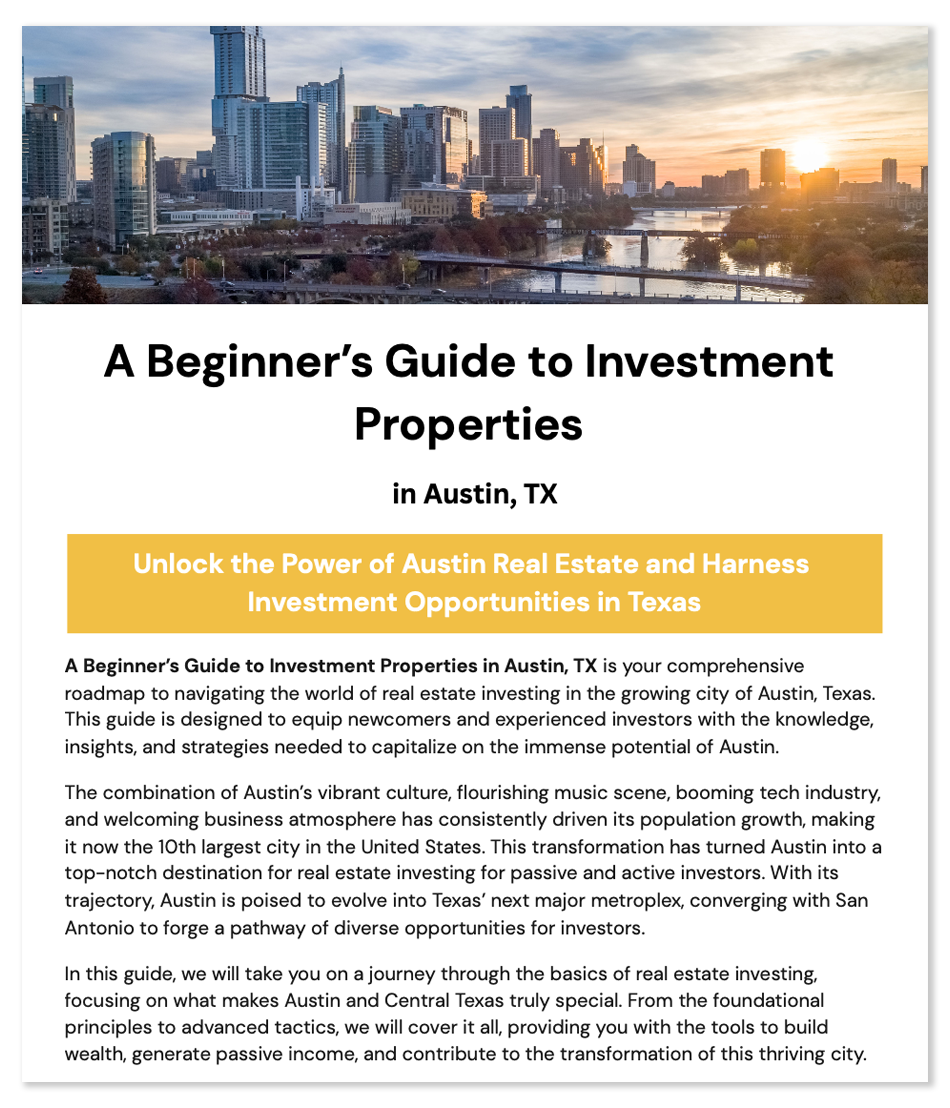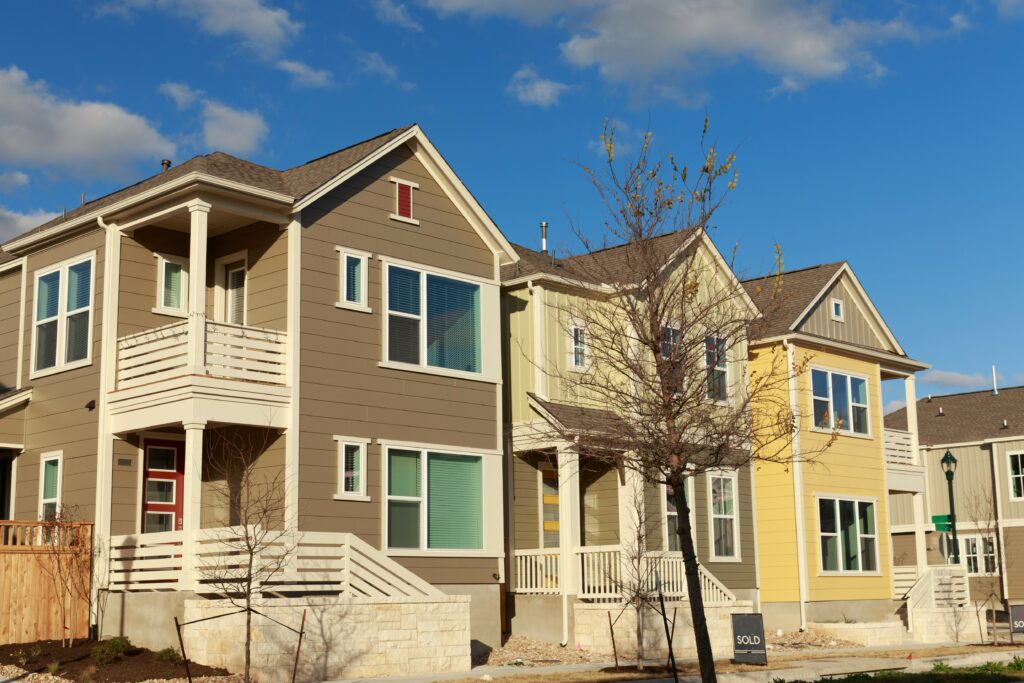In Austin’s dynamic real estate landscape, every investment decision can lead to a different growth path.. Whether you’re a seasoned investor or just starting, understanding the nuances of this real estate market and different asset classes is important.
Austin Multifamily Real Estate Questions
Our blog aims to address some of the most pressing questions regarding real estate investments. We will cover topics such as the viability of real estate investments in the coming years, the safety and profitability of such ventures, the basics of how real estate investing works, and the specific benefits of multifamily properties.
Additionally, we will explore various investment strategies suitable for different levels of investors, with a focus on multifamily real estate and how it fits into the dynamic Austin market.
Join us, a boutique real estate investment firm, as we answer these burning questions, providing you with the clarity and confidence needed in your real estate investment journey.
Is It Worth It to Invest in the Multifamily Sector in 2024?
Market Trends for the Multifamily Sector in 2024
As we move into 2024, let’s take a closer look at a topic that’s important for investors in the multifamily industry. This isn’t just about general market trends; it’s about comprehending how these changes could specifically impact investments in the multifamily sector. If interest rates decrease in 2024, multifamily investors may experience several effects:
Older Properties Above Average Rent Growth: According to the CBRE research, investors should pay close attention to older multifamily properties. Over the past decade, properties constructed before 2010 have experienced an impressive average annual rent growth of 4.6%, surpassing the 3.4% growth rate of post-2010 assets.
This can be attributed to the fact that pre-2010 properties have lower average rents, allowing for significant growth in a continuously high-demand housing market. Additionally, the rent growth of older properties has shown to be more stable and less susceptible to external shocks such as recessions.
Improved Financing Conditions: If interest rates are lowered, it will become less expensive for investors to borrow money. This can benefit those who currently have high-leverage loans or floating-rate debts. They will be able to refinance existing properties or purchase new ones with increased cash flowThe money that is left over each month or year from the property's income after paying for operating costs, mortgage, taxes, and other expenses. Positive cash flow occurs when the income exceeds the expenses, while negative cash flow indicates that the property's expenses are higher than the income it generates. View Definition and better debt service coverage ratios.
Market Rebalancing: The multifamily housing sector has seen an increase in the number of available units and a decline in rental rates. However, the market may soon reach a balance due to the reduced cost of financing. This could lead to a more stable market and make investing in multifamily properties, especially in Class B assets, more appealing in the long run.
Potential for Portfolio Expansion: The combination of lower borrowing costs and stable rental demand creates a favorable environment for portfolio expansion. Investors may find it advantageous to acquire additional properties, especially Class B assets, which offer a balance of affordability and quality for tenants. Learn More →

Like what you see? Don’t miss out on future insights! Subscribe to Wildhorn Capital’s Monthly Newsletters for exclusive updates and expert analysis. Join our community of informed subscribers today.
How Does Investing in Real Estate Work?
Foundations of Real Estate Investment
In real estate investment, you’ll primarily encounter two types of assets: Residential and Commercial Real Estate.
Residential properties, designed for living, include single-family homes and multifamily properties like duplexes or apartment buildings. Single-family homes stand alone, offering privacy and independence, while multifamily properties consist of several units sharing common walls.
On the other hand, Commercial Real Estate, used for business and income generation, spans various types like office spaces, retail locations, and industrial facilities. The value of commercial properties often hinges on the business performance of the tenants, and purchasing these properties typically requires different financing approaches compared to residential real estate.
Types of Real Estate Investment Strategies
In Central Texas, real estate investing offers several residential and multifamily strategies to generate returns.
Residential strategies, suitable for properties with 1 to 4 units, require more direct involvement. These include:
- Fix and Flip where investors renovate distressed properties for a quick sale
- Buy and Hold for long-term appreciationThe increase in the value of a property over time, usually due to factors such as market demand, economic growth, infrastructure improvements, and inflation. View Definition and rental income
- Short-Term Rentals for unique or large-group accommodations
- Wholesaling is where investors find and assign undervalued properties
- BRRRR Strategy (Buy, Rehab, Rent, Refinance, Repeat) for continuous investment cycling
- Condo Conversion to transform apartments into condos.
For larger residential properties, multi-housing strategies are effective.
- Value-AddValue-add is a strategy where an investor or property owner seeks to increase the value of a property by making significant improvements or changes to it. The goal is to enhance the property's appeal, functionality, and income-generating potential, which can lead to higher rental income, increased property valuation, and improved overall performance. View Definition Investing involves improving underperforming multifamily properties to boost their value and rental income.
- Syndications pool resources from various investors to acquire larger properties, offering returns proportional to each investor’s contribution.
- Ground-Up DevelopmentA term used to signify starting a project from an empty plot of land or an undeveloped site, rather than renovating or expanding an existing structure. View Definition is about constructing new buildings or communities on undeveloped land, often in partnership with developers, encompassing planning, permitting, and construction phases.
These strategies, each with unique approaches and benefits, offer diverse ways for investors to engage in the vibrant Central Texas real estate market.
Benefits of Real Estate Investing
Investing in real estate in Austin, Texas, presents several key benefits for those looking to build long-term wealth. First, rental properties in the area can offer a steady source of passive income through positive cash flow, where the income generated by the property surpasses its operating costs, mortgage, taxes, and other expenses. Additionally, Austin’s robust and growing economy contributes to the appreciation of property values, offering investors the opportunity for significant wealth accumulation over time.
Moreover, real estate investments come with tax advantages, such as deductions on mortgage interest and property taxes, which can be maximized with professional advice. This investment avenue also serves as a tool for diversifying your portfolio and spreading your wealth across different types of investments to mitigate risk. Furthermore, real estate investing is a powerful means to build generational wealth, allowing you to accumulate properties and pass them down, creating a financial legacy for future generations.
Learn More: A Beginner’s Guide to Investment Properties Austin TX

Ready to take your real estate investment knowledge to the next level?
Don't miss out on our comprehensive PDF guide: 'A Beginner’s Guide to Investment Properties in Austin, TX.'
Pros and Cons of Investing in Multifamily Properties
Investing in multifamily properties can be a lucrative venture, but like any investment, it comes with its own set of advantages and challenges. Here’s a look at some of the key pros and cons:
Benefits of Multifamily Real Estate Investing
Economies of Scale: Managing multiple units in the same location can be more cost-effective than managing the same number of single-family homes spread out in different locations. Costs for maintenance, repairs, and property management services are often lower on a per-unit basis for multifamily properties.
Value-Add Opportunities: Multifamily properties often offer more opportunities to add value and increase rents. For example, we might add amenities like a fitness center or community space, or upgrade individual units to justify higher rents.
Potential for Cash Flow and Appreciation: Multifamily properties, with their multiple rental units, offer a reliable income stream through rental payments. The cash flow generated from these properties can provide passive income to investors.
Cons of Multifamily Real Estate Investing
Higher Initial Investment: Multifamily properties typically come with a higher price tag compared to single-family homes, making the initial investment and financing more challenging.
Management Intensity: Managing a multifamily property can be more complex and time-consuming. Issues like tenant turnover, maintenance requests, and property management are intensified with more units. That is why at Wildhorn Capital we outsource our property management.
Learn More: A deep dive into outsourcing property management →
Market Sensitivity: The value of multifamily properties can be more sensitive to changes in the real estate market and economic conditions. Factors like employment rates, local market trends, and changes in rental demand can significantly impact performance.
Tenant Turnover: While single-family homes often attract long-term tenants, multifamily units can see higher tenant turnover, leading to increased costs for marketing, leasing, and preparing units for new tenants.
You should weigh these factors based on their individual resources, experience, and investment goals before making any decisions.
Learn More: Multifamily Investing →

What are the different types of real estate investments?
Types of Real Estate Investing
We will explore three popular avenues for Central Texas passive real estate investing: REITsReal Estate Investment Trust: financial operation designed to allow individual investors to invest in large-scale, income-producing real estate assets without having to directly own or manage the properties themselves. View Definition, crowdfunding platforms, and real estate syndications. Whether you’re a seasoned investor or new to the game, understanding these investment vehicles can help you diversify your portfolio and potentially earn passive income from the thriving real estate market
Real Estate Investment Trusts (REITs)
- What They Are: REITs are companies that own or finance real estate properties. They’re like mutual funds for real estate, allowing you to invest in properties without buying them yourself.
- Benefits: REITs are traded on stock exchanges, so you can easily buy and sell your shares. They pay out most of their income as dividends, giving investors a regular income stream.
- Ideal For: Investors who want a straightforward way to invest in real estate without dealing with the complexities of property ownership.
Crowdfunding Platforms
- What They Are: An online platform where various investment firms can market their investments to attract additional investors.
- Benefits: They are easy to use and accessible to most investors, offering a variety of investment options. You earn a share of the profits proportional to your investment.
- Considerations: It can be harder to evaluate the quality of the investment firms, and there might be lower returns due to fees and lower investment thresholds.
Real Estate Syndications
- What They Are: This is a group investment where multiple investors pool their money to fund a real estate project. A lead investor or sponsor manages the project.
- Benefits: Allows you to invest in large real estate projects with professional management. You get returns from rental income, property appreciation, or profits when the property is sold or refinanced.
- Ideal For: Investors looking to be part of bigger real estate deals without managing the property themselves.
Learn More: Passive Real Estate Investing →

Is Austin a Good Place to Invest in Real Estate?
Austin’s strong job market, population growth, and economic stability make it an attractive real estate investment destination.
Tech Industry Drives Job Growth
Austin has seen a boom in the tech industry with companies like Apple and Tesla coming to town, which drives strong job growth as well as increased housing demands. Austin has consistently been one of the top job markets and fastest-growing town in America. With fewer business regulations, lower taxes, and an affordable cost of living, Austin has become the new go-to hub for tech companies.
Population Growth and Demand
As the population of Austin and surrounding areas such as Manor, Texas continues to expand rapidly, it is creating a great opportunity for real estate investors. This growth can be attributed in part to an influx of young professionals searching for vibrant lifestyle options who are drawn by lower housing prices nearby Cedar Park which has seen a significant increase in its residents over the past 10 years – up 57%.
Austin has a 2023 population of 966,292. It is also the county seat of Travis County. Austin is currently growing at a rate of 0.11% annually and its population has increased by 0.33% since the most recent census, which recorded a population of 963,121 in 2020.
The city itself now consists largely of millennials seeking rental properties instead of long-term homeownership contracts. This high-demand environment creates perfect conditions wherein investments into Austin’s property market may appreciate with time. With so many people moving there, investing in real estate provides anyone willing another potential means from which they may benefit from their area’s continual advancement.
Austin is an appealing spot for real estate investors, providing both the potential for large gains and economic advantages including notable tax deductions.
Learn More: Should I Invest in Austin Real Estate?
Why Should I Add Real Estate to My Portfolio?
Real estate is a unique type of asset that experts recommend including in a diversified investment portfolio. The reason for this is that real estate investments don’t tend to move in the same direction as stocks, bonds, or commodities. Moreover, real estate investments have the potential to generate rental income or mortgage payments, as well as capital gains over time.
Learn More: Simple Ways to Invest in Real Estate

Andrew Campbell is a native Austinite and Managing Partner at Wildhorn. He is a real estate entrepreneur who first broke into the business in 2008 as a passive investor. In 2010 he transitioned into active investing and management of a personal portfolio that grew to 76 units across Austin and San Antonio. He earned his stripes building and managing his personal portfolio before founding Wildhorn Capital and focusing on larger multifamily buildings. At Wildhorn, he is focused on Acquisitions and maintaining Investor Relations, utilizing his marketing and communications background to build long-term relationships.







